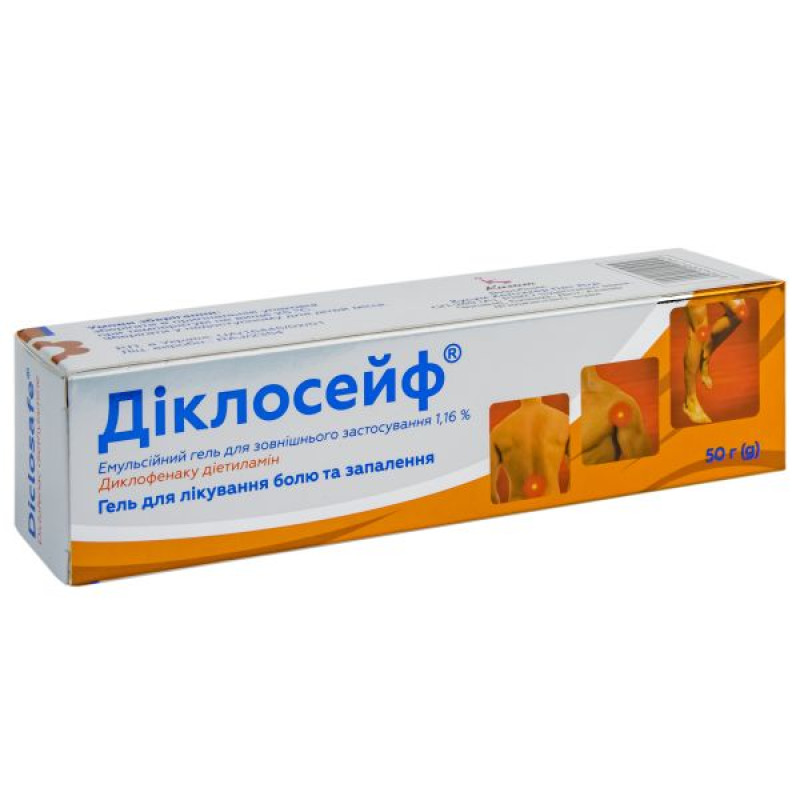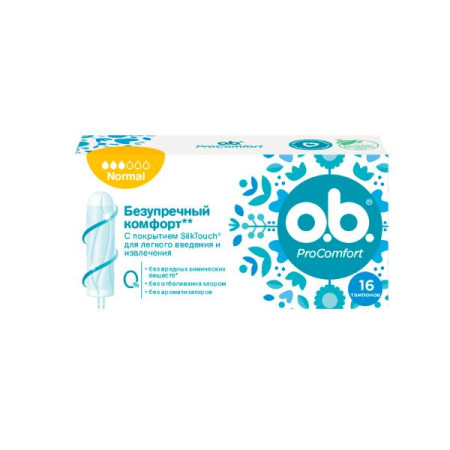Diclosafe emulsion gel for external use 1.16% tube 50 g

Instructions Diclosafe emulsion gel for external use 1.16% tube 50 g
Composition
active ingredient: diclofenac diethylamine;
1 g of gel contains 11.6 mg of diclofenac diethylamine, equivalent to 10 mg of diclofenac sodium;
excipients: propylene glycol, isopropyl alcohol, carbomer, diethylamine, cocoyl caprylocaprate, oleyl alcohol, polyethylene glycol cetostearyl ether, light mineral oil, butylhydroxytoluene (E 321), purified water.
Dosage form
Emulsion gel for external use.
Main physicochemical properties: white or almost white homogeneous soft gel.
Pharmacotherapeutic group
Topical agents for joint and muscle pain. Nonsteroidal anti-inflammatory drugs for topical use. Diclofenac.
ATX code M02A A15.
Pharmacodynamics
Dicloceif with the active ingredient diclofenac is a nonsteroidal anti-inflammatory drug for external use.
Diclofenac is an NSAID that has pronounced antirheumatic, analgesic, anti-inflammatory and antipyretic effects. The main mechanism of action is the inhibition of prostaglandin biosynthesis.
In inflammation caused by trauma or rheumatic diseases, diclofenac gel reduces pain, tissue swelling and shortens the period of restoration of functions of damaged joints, ligaments, tendons and muscles. Clinical data have proven that diclofenac gel reduces acute pain within 1 hour after initial application. The drug reduces pain during movement by 75% within two days. 94% of patients had a positive response to diclofenac gel after 2 days of treatment compared to 8% of patients who had a positive response to placebo. Overcoming pain and functional disorders was achieved after 4 days of treatment with diclofenac gel. Due to the water-alcohol base, the drug also has a local anesthetic and cooling effect.
Pharmacokinetics
The amount of diclofenac absorbed through the skin is proportional to the area of application and depends on both the total dose of the drug and the degree of skin hydration. After topical application of 2.5 g of diclofenac gel to a skin surface area of 500 cm2, the degree of absorption of diclofenac is approximately 6%. The use of an occlusive dressing for 10 hours leads to a threefold increase in diclofenac absorption.
After application of diclofenac gel to the skin of the hand and knee joints, diclofenac is found in the blood plasma (where its maximum concentration is approximately 100 times lower than after administration), in the synovial membrane and synovial fluid. The protein binding of diclofenac is 997%.
Diclofenac accumulates in the skin, which serves as a reservoir from which the substance is gradually released into the surrounding tissues. From there, diclofenac mainly enters deeper inflamed tissues, such as joints, where it continues to act and is detected in concentrations up to 20 times higher than in blood plasma.
Diclofenac is metabolized by hydroxylation to form several phenolic derivatives, two of which are pharmacologically active, but to a much lesser extent than diclofenac.
Diclofenac and its metabolites are excreted mainly in the urine. The total systemic clearance of diclofenac is 263±56 ml/min and the terminal half-life is on average 1-3 hours.
In renal or hepatic insufficiency, the metabolism and excretion of diclofenac are not altered.
Indication
Local treatment of pain and inflammation of joints, muscles, ligaments and tendons of rheumatic or traumatic origin.
Contraindication
- hypersensitivity to diclofenac or other components of the drug;
- history of attacks of bronchial asthma, urticaria or acute rhinitis caused by taking acetylsalicylic acid or other nonsteroidal anti-inflammatory drugs;
- the last trimester of pregnancy;
- age up to 14 years.
Interaction with other medicinal products and other types of interactions
Since systemic absorption of diclofenac following topical administration is very low, the likelihood of interactions is very low. There are currently no data on interactions with topical diclofenac. Information on known interactions with oral forms of diclofenac can be found in the relevant sources.
Application features
The likelihood of developing systemic side effects with topical application of diclofenac is insignificant compared to the use of its oral forms, but it cannot be ruled out when the drug is used on relatively large areas of skin for a long time.
The drug should be used with caution simultaneously with oral nonsteroidal anti-inflammatory drugs, as the frequency of undesirable, especially systemic, side effects may increase (see section "Interaction with other medicinal products and other types of interactions").
Diclosafe gel should not be used simultaneously with other drugs containing diclofenac.
If any skin rashes appear, treatment with the drug should be discontinued.
Diclosafe gel should not be applied under an airtight occlusive dressing, but it may be applied under a non-occlusive dressing. In the event of a ligament sprain, the affected area can be bandaged.
With topical use of diclofenac, there is a certain possibility of gastrointestinal bleeding in patients who have had it in the past.
Diclosafe gel contains propylene glycol and butylhydroxytoluene. Propylene glycol may cause skin irritation. Butylhydroxytoluene may cause local skin reactions (e.g. contact dermatitis) or irritation of the eyes and mucous membranes.
Ability to influence reaction speed when driving or operating machinery
No effect.
Use during pregnancy or breastfeeding
Pregnancy.
After topical application of diclofenac, its systemic concentration is lower compared to oral administration. Taking into account the experience of systemic NSAID therapy, it is recommended to consider the following.
Inhibition of prostaglandin synthesis may adversely affect the course of pregnancy and/or embryo/foetal development. Epidemiological studies have shown an increased risk of miscarriage and/or cardiac malformations and gastroschisis following the use of a prostaglandin synthesis inhibitor in early pregnancy. The absolute risk of cardiovascular malformations was increased from less than 1% to 1.5%. The risk is thought to increase with dose and duration of treatment. In animals, administration of a prostaglandin synthesis inhibitor has been shown to result in increased pre- and post-implantation loss and embryo/foetal lethality.
In addition, an increased incidence of various malformations, including cardiovascular, has been reported in animals treated with a prostaglandin synthesis inhibitor during organogenesis. During the first and second trimesters of pregnancy, diclofenac should not be used unless clearly necessary. If diclofenac is used by a woman attempting to conceive, or if the drug is used during the first or second trimester of pregnancy, the dose should be kept as low and the duration of treatment as short as possible.
In the third trimester of pregnancy, all prostaglandin synthesis inhibitors may affect the fetus in the following ways:
- cardiopulmonary toxicity (with premature closure of the ductus arteriosus and pulmonary hypertension);
- renal dysfunction, which may progress to renal failure with oligohydramnios;
The use of prostaglandin synthesis inhibitors in late pregnancy may affect the mother and newborn in the following ways:
- possible prolongation of bleeding time, antiplatelet effect, which can be observed even at very low doses;
- inhibition of uterine contractions, leading to delayed or prolonged labor.
Therefore, diclofenac is contraindicated during the third trimester of pregnancy (see section "Contraindications").
Breast-feeding.
Like other NSAIDs, diclofenac passes into breast milk in small amounts. However, when using therapeutic doses of Diclosafe gel, no effect on breastfeeding is expected. Due to the lack of controlled studies in breastfeeding women, Diclosafe gel should be used during this period only as prescribed by a doctor. During breastfeeding, the drug should not be applied to the mammary glands or large areas of skin and should not be used for a long time (see sections "Special instructions for use" and "Method of administration and dosage").
Fertility.
There are no data on the effect of diclofenac on human fertility when applied topically.
Method of administration and doses
Adults and children over 14 years of age: Diclosafe gel should be applied 3-4 times a day, gently rubbing into the skin. The amount of the drug used depends on the size of the affected area (for example, 2-4 g, which is the size of a cherry or walnut, is enough to cover an area of 400-800 cm2).
After applying the drug, it is necessary to wash your hands, except in cases where this is the area to be treated.
The duration of therapy depends on the nature of the disease and the effectiveness of the treatment.
The drug should not be used for longer than 14 consecutive days for soft tissue injuries or rheumatism and for longer than 21 days for pain in arthritic joints, unless otherwise recommended by a doctor.
You should consult a doctor if the symptoms of the disease do not improve or worsen after 7 days of treatment.
Elderly patients: no dose adjustment is required.
If Diclosafe gel is applied to large areas of the body, systemic absorption of diclofenac will be greater and the risk of adverse reactions will increase, especially if the therapy is used frequently.
Children.
Since there is insufficient data on the efficacy and safety of diclofenac gel in children under 14 years of age, the drug is contraindicated in children under 14 years of age (see section "Contraindications"). When using the drug in children over 14 years of age for more than 7 days or if the symptoms of the disease worsen, a doctor should be consulted.
Overdose
Overdose is unlikely due to the low absorption of diclofenac into the systemic bloodstream when applied topically. At the same time, the development of systemic adverse reactions may occur in case of accidental ingestion of Diclosafe gel (it should be borne in mind that 1 tube of the drug of 30 g contains the equivalent of 0.3 g of diclofenac sodium). In case of accidental ingestion of the drug and the occurrence of significant systemic adverse reactions, general therapeutic measures used in the treatment of poisoning with nonsteroidal anti-inflammatory drugs should be applied. Gastric lavage and administration of activated charcoal are recommended, especially in cases where the drug was ingested recently.
Treatment.
Treatment of overdose with nonsteroidal anti-inflammatory drugs consists of supportive and symptomatic therapy. There is no typical clinical picture caused by an overdose of diclofenac gel. Supportive and symptomatic treatment is indicated for complications such as arterial hypotension, renal failure, convulsions, gastrointestinal disorders and respiratory depression. Forced diuresis, hemodialysis or hemoperfusion are unlikely to be useful for the removal of NSAIDs, since the active substances of these drugs are highly bound to plasma proteins and undergo extensive metabolism.
Adverse reactions
Diclofenac gel is generally well tolerated. Adverse reactions include mild, transient skin reactions at the application site. In rare cases, allergic reactions may occur.
Infections and infestations: pustular eruptions.
Immune system disorders: hypersensitivity reactions (including urticaria), angioedema.
Respiratory, thoracic and mediastinal disorders: bronchial asthma.
Skin and subcutaneous tissue disorders: rash, itching, eczema, erythema, dermatitis, including contact dermatitis, bullous dermatitis, photosensitivity reactions, skin burning.
When using diclofenac topically, the possibility of adverse reactions that are usually associated with its systemic use cannot be excluded (see section "Special warnings and precautions for use").
Expiration date
2 years.
Storage conditions
Store in the original packaging at a temperature not exceeding 25 °C.
Keep out of reach of children.
Packaging
30 g in a tube, 1 tube in a cardboard box.
Vacation category
Without a prescription.
Producer
Kusum Healthcare PVT Ltd.
Location of the manufacturer and its business address/
SP-289(A), RIIK Industrial Area, Chopanki, Bhiwadi, get. Alwar (Rajasthan), India.
There are no reviews for this product.
There are no reviews for this product, be the first to leave your review.
No questions about this product, be the first and ask your question.











